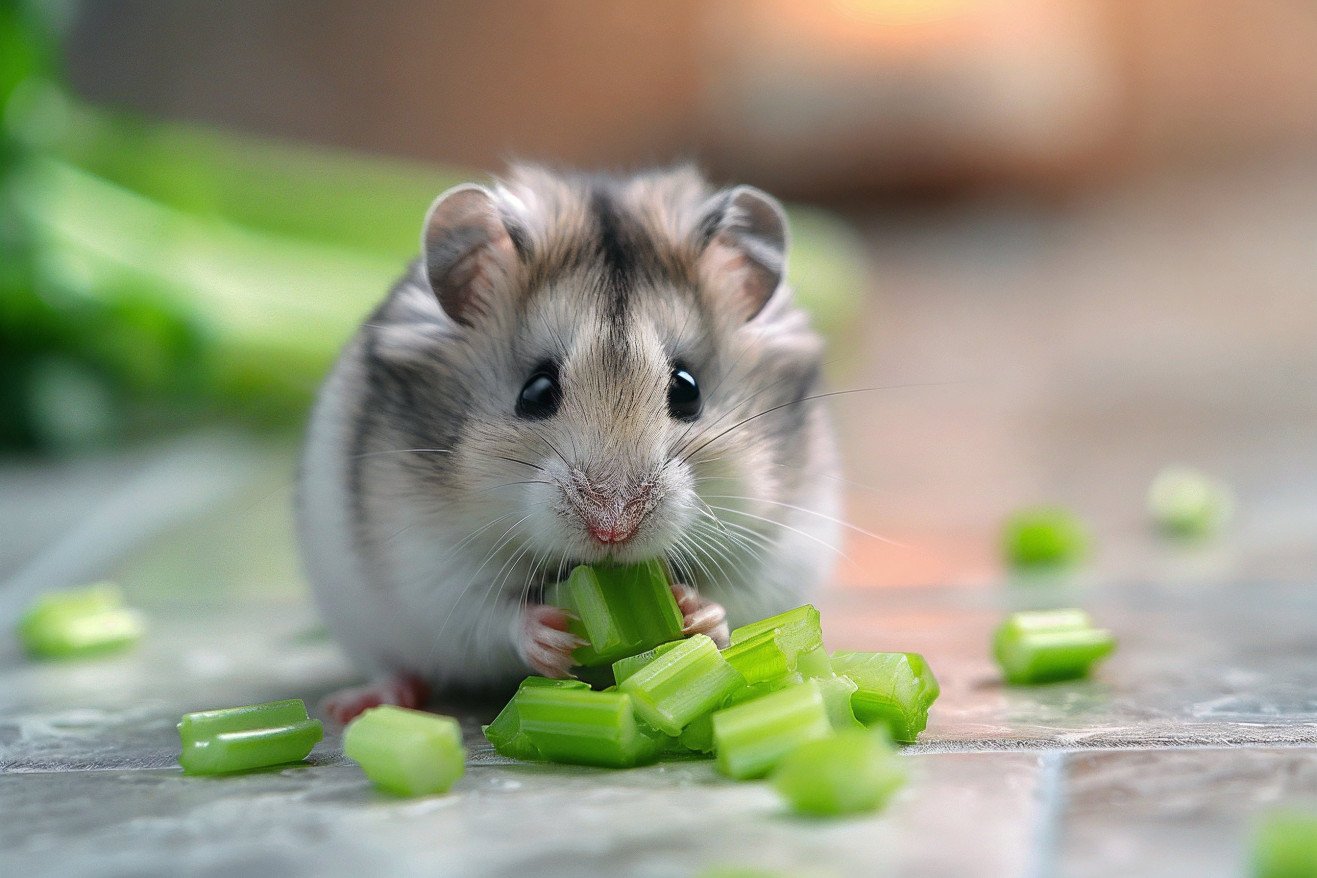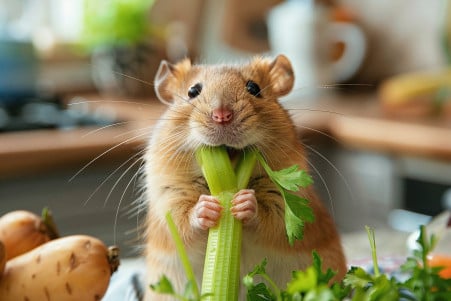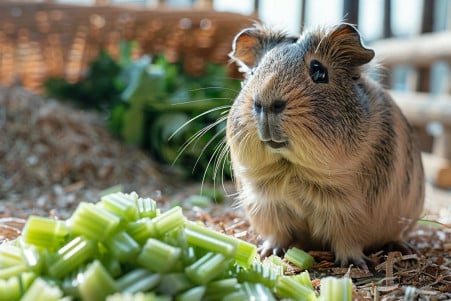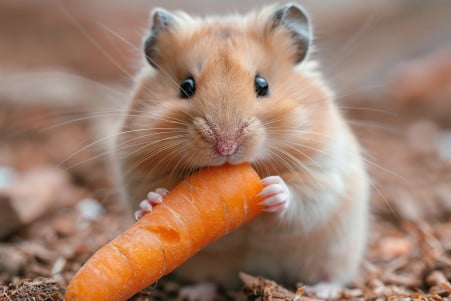Can Hamsters Eat Celery? What You Need to Know
27 March 2024 • Updated 27 March 2024

If you’re a hamster owner, you may be curious if your pet can enjoy the crunchy, low-calorie vegetable known as celery. The good news is that celery is one of the vegetables that is safe for hamsters to eat in moderation - it’s low in calories and sugar and has a little bit of fiber, vitamins, and minerals that can be good for your hamster.
However, celery is also high in water, which means that it can cause diarrhea if hamsters eat too much of it. In this article, we’ll go over what both vets and experienced hamster owners have to say about how much celery is safe for hamsters to eat and how to introduce it into their diet.
Can hamsters eat celery?
Celery's Nutritional Value for Hamsters
Celery can be a nutritious addition to a hamster's diet and contribute to their overall wellness. It is high in fiber, which PetMD notes is important for a healthy digestive system. Celery also contains vitamins A, C, and K, and it is an antioxidant, which Pet Keen says can help support a hamster's immune system.
Despite the nutritional value of celery, it is also high in water, so it should not make up a large part of a hamster's diet. Hepper recommends that a hamster's diet should be made up of about 75% pellet and seed mix, 20% fresh vegetables like celery, and 5% treats. Feeding a hamster too much celery can lead to digestive problems, including diarrhea.
To feed celery safely, give your hamster a small amount once or twice a week as part of their fresh food allotment. You can mix finely chopped celery in with their regular food, or give it to them as a snack between meals. If you're feeding your hamster celery for the first time, start with a small amount to make sure it doesn't cause any digestive upset. Because of its fiber, vitamins, and antioxidants, celery can be a good choice to add to your hamster's diet as long as it's part of a balanced, varied meal plan.
Appropriate Portion Sizes and Frequency
When you give your hamster celery, it’s important to make sure that you’re only giving them small amounts and that you’re only giving it to them on occasion. Per Pet Keen, a good portion size is about 1/2 teaspoon of finely chopped celery, and you should only give it to them once or twice a week. Hamsters don’t need a lot of celery to get the benefits of its nutrients.
The Pet Food Guide recommends that you start with even smaller portions when you first start giving your hamster celery and that you watch them closely to see how they react. If they don’t have any negative reactions, such as diarrhea or bloating, you can increase the portion size.
Make sure that you don’t give them too much, though, because Hamsters Portal warns that overfeeding them celery can cause vomiting and excessive urination. By starting with small amounts and increasing the portion size, you can make sure that you’re giving them the right amount for their personal needs and preferences.
How to Prepare and Serve Celery
Proper preparation is important when it comes to feeding your hamster celery. First, make sure you wash the celery thoroughly to remove any dirt, pesticides, or other contaminants that could be harmful to your pet. Wood Hamster Cage notes that you should then cut the stalks into small pieces and remove any strings to avoid choking or other digestive problems.
As for serving, The Pet Food Guide recommends mixing the small pieces of celery in with your hamster's regular food to add some extra nutrition to their diet. You can also give celery to your hamster as a treat on its own, but the recommended serving size is up to 1/2 teaspoon. If your hamster is sick, you can even make a vegetable broth by blending celery with water, according to Pet Keen.
Finally, make sure to store any unused celery in an airtight container in the refrigerator and throw out any uneaten celery after one or two days to make sure it doesn't go bad. By preparing and serving celery properly, you can make sure it's a safe and healthy addition to your hamster's diet.
Potential Dangers and Pitfalls
Although celery can make a nutritious and delicious snack for hamsters, it's important to be aware of the potential dangers of overfeeding. According to Hamsters Portal, overconsumption of celery can lead to problems like vomiting and excessive urination in hamsters. Because of its high water content, celery should be fed in small amounts to avoid digestive problems.
As pointed out by the professionals at Pet Food Safety, signs of digestive issues that may be caused by overeating celery include diarrhea, bloating, and a loss of appetite. If you notice any of these symptoms after introducing celery to your hamster, you should consider decreasing the amount you give them or eliminating it from their diet.
My Family Vets recommends starting with a very small amount, such as 1/2 teaspoon, and observing your hamster's response. If your hamster handles the celery well, you can gradually increase the portion. If your hamster eats too much celery, contact your vet immediately for advice.
It's especially important to be careful when feeding celery to hamsters that have a history of digestive issues or other health conditions. Always talk to your vet before adding new foods to your hamster's diet to make sure it's safe and suitable for their specific circumstances.
Celery Leaves and Roots: Safe or Not?
The leaves of the celery plant are safe for hamsters and can even offer some nutritional value. Per We're All About Pets, celery leaves are a good treat for hamsters, but the site recommends that you only give your pet about one large leaf or two small leaves at a time to avoid stomach issues. The leaves have many of the same vitamins and minerals as the stalks, so they can be a healthy part of a hamster's diet.
Meanwhile, the root of the celery plant is not listed as safe or unsafe for hamsters by The Hamster Forum. The forum's general advice is that celery is safe to feed to hamsters as long as the stringy parts are removed. However, it's still a good idea to introduce the root in small amounts and gradually, while watching for any negative reactions from your hamster.
If you're going to feed your hamster celery leaves or roots, make sure you wash them well and cut them into very small, bite-sized pieces to prevent choking. And as with the stalks, make sure you feed your hamster a small amount at first and then gradually increase the serving if they don't have any issues. Keep a close eye on your pet for any signs of stomach problems after you give them new parts of the celery plant.
Wrapping Up: Understanding Celery's Suitability for Hamsters
Celery can be a healthy and nutritious treat for hamsters when fed in moderation as part of a balanced diet. It provides valuable vitamins, minerals, and fiber that support a hamster's overall wellbeing. However, the high water content means celery should be introduced slowly and portions should be limited to prevent digestive upset.
When preparing celery for your hamster, be sure to wash it thoroughly and cut the stalks into small, bite-sized pieces to avoid choking hazards. You can also offer the nutrient-dense celery leaves, though your hamster may be hesitant to try them at first.
If you have any specific concerns about incorporating celery or other foods into your hamster's diet, it's best to consult with your veterinarian. They can provide personalized guidance to ensure your furry friend is getting all the nutrients they need while avoiding potential risks. As with any new food, monitor your hamster's reaction closely and adjust portion sizes accordingly.


